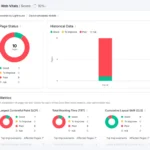
Optimizing product descriptions is just one part of e-commerce SEO. In 2026, the most successful online stores focus on full product page optimization, which includes meta tags, structured data, visuals, and user experience—all designed to help search engines understand your products while enticing customers to buy.
A well-optimized product page not only ranks higher in search engines but also increases conversions, reduces bounce rate, and builds brand credibility.
Why Optimizing Product Pages is Crucial for SEO
- Improves Organic Rankings
Search engines analyze your product pages to determine relevance for specific queries. Optimized titles, meta descriptions, and structured content help Google understand your offerings, leading to higher rankings. - Enhances User Experience (UX)
A clean, informative, and visually appealing product page keeps users engaged. Pages that satisfy both search engines and users see higher rankings and better conversion rates. - Boosts Click-Through Rates (CTR)
Well-written product titles and meta descriptions with clear benefits attract more clicks from SERPs, which signals search engines that your page is valuable. - Drives Conversions
Optimized product pages address user pain points, highlight benefits, and answer questions, encouraging customers to make a purchase. - Supports Voice and Mobile Search
Structured and concise product information ensures your page is voice-search-friendly and mobile-responsive, two factors that influence modern SEO.
Key Elements of an SEO-Friendly Product Page
1. Keyword Research for Product Pages
- Identify high-intent keywords relevant to the product.
- Use long-tail keywords to capture specific buying intent, e.g., “wireless noise-canceling headphones for travel.”
2. Compelling Product Titles
- Include the primary keyword naturally.
- Highlight unique selling points (USP).
- Avoid keyword stuffing; keep it readable and appealing.
3. Detailed Product Descriptions
- Use benefit-driven language that explains how the product solves customer problems.
- Incorporate secondary keywords naturally.
- Format descriptions with bullet points, headings, and short paragraphs for readability.
4. High-Quality Images and Videos
- Include multiple images showing the product from different angles.
- Add product demonstration videos for engagement.
- Use optimized alt text for all media, including relevant keywords.
5. Meta Titles and Descriptions
- Craft unique meta titles that include primary keywords.
- Write persuasive meta descriptions that encourage clicks.
6. Structured Data (Schema Markup)
- Implement product schema to provide search engines with details like price, availability, and reviews.
- Rich snippets improve SERP visibility and CTR.
7. User Reviews and Ratings
- Encourage customers to leave reviews.
- User-generated content increases trust, content freshness, and keyword relevance.
8. Internal Linking
- Link to related products, categories, and blog content.
- Helps distribute authority and improves site crawlability.
9. Mobile Optimization
- Ensure the page is responsive and fast-loading.
- Mobile-friendly pages improve user experience and positively influence rankings.
10. Clear Call-to-Actions (CTAs)
- Make it easy for users to add products to the cart or checkout.
- Well-placed CTAs improve conversion rate, indirectly supporting SEO through engagement metrics.
Our Services SEO Services in Jehanabad | SEO Services in Gaya | SEO Services in Gurgaon | SEO Services in Uppal
Key Takeaways
- Product pages are crucial for e-commerce SEO and conversions.
- Optimizing product titles, descriptions, media, structured data, and reviews enhances both search engine visibility and user experience.
- Combining keyword strategy, content optimization, and technical SEO ensures pages are rank-ready and sales-ready.
FAQs
1. How do product variations affect SEO?
Product variations (size, color, style) should use canonical tags or structured data to prevent duplicate content issues, while still making all variations visible for users.
2. Can meta descriptions directly improve rankings?
Meta descriptions do not directly affect ranking but influence click-through rates, which indirectly signals page relevance to search engines.
3. Should I focus on benefits or features in product descriptions?
Both are important, but emphasizing benefits helps users understand why they should buy, while features provide technical details that search engines can index.
4. How important is page load speed for product pages?
Critical. Slow-loading pages increase bounce rates, negatively impacting rankings and conversions. Optimizing images, caching, and code is essential.
5. Can structured data affect how my products appear in search results?
Yes. Structured data enables rich snippets, showing prices, reviews, and availability directly in search results, which can boost CTR.
6. Do user-generated questions on product pages help SEO?
Yes. Questions and answers add fresh, keyword-rich content, improve engagement, and increase the likelihood of appearing in featured snippets.
7. How often should I update product pages for SEO?
Regularly. Updating pages with new content, seasonal promotions, reviews, or FAQs keeps them relevant, which search engines favor.
Conclusion
Optimizing product pages is a critical aspect of modern e-commerce SEO. From keyword research to structured data, images, reviews, and internal linking, every element works together to increase rankings, drive traffic, and boost conversions.
Businesses that consistently enhance their product pages with both SEO best practices and user-focused content will dominate search results while providing an exceptional shopping experience.





